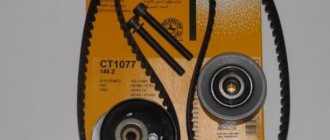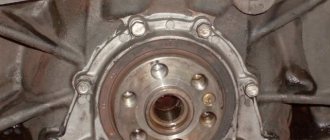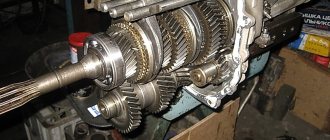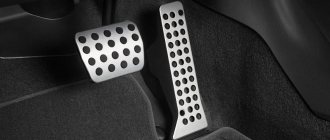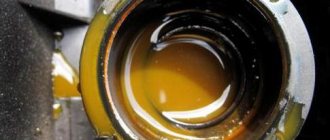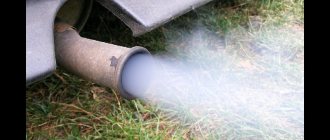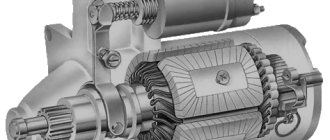18.07.2019
| (Votes: 1, Rating: 1) |
Issues discussed in the material:
- How are current consumers connected to the vehicle's on-board system?
- What can cause current leakage in a car?
- How to detect a current leak in a car yourself
- How to eliminate current leaks in a car
- What are the dangers of current leaks in a car?
In the evening you left the car with a charged battery, but the next day you discovered that it was dead. What could be the problem? How to check for current leakage in a car? Is it possible to eliminate a possible breakdown? Let's figure it out.
The principle of connecting current consumers to the on-board network
Electric current will flow through the conductor only if the electrical circuit is closed. Electricity consumption should be normal - battery terminal “plus” - consumer - terminal “minus”, and the circuit should not be broken. As an example, we gave the simplest scheme. In your car, consumers are connected to a circuit whose complexity is several times higher. Therefore, it will be difficult for a non-professional auto electrician to understand all the nuances.
How to check for current leakage in a car? Refer to the image above. On it you can see that there is a single “minus” between the lamp and terminal 85 of the relay; it is usually connected to ground (body).
In this case, a switch is installed on the positive wire, breaking the circuit. When the switch contacts close, electricity flows through the relay coil, which is connected to pins 85 and 86. Due to the electromagnetic field, the coil begins to close the 87th and 30th contacts, and the electric current flows through the lamps.
The described scheme is standard for most vehicles. However, usually the circuit is opened by an additional switch - the ignition switch, and the fuse is embedded in the positive wire. To make it more convenient, one or two mounting blocks combine relays with fuses. Knowing this, you won't be shocked when you see a lot of wiring harnesses. You can also, by dividing a huge number of connected circuits into mini-circuits, check for current leakage in a car using clamps.
Some car devices are combined into common networks. Imagine that this is one consumer, but simply expanded in space. Is a current leak detected in the car after checking? The reason is that different circuits are connected to each other or to the “ground” of the machine due to the fact that the wiring insulation has become unusable. Leakage can also occur due to electric current “bridges” that appear due to dirt.
We recommend
“Checking the brake fluid: a guarantee of road safety” Read more
Why is a current leak in a car dangerous?
Checking the current leakage of a car battery is important because one of the unpleasant consequences can be that the battery is completely discharged. Of course, the battery can be recharged, but this will not solve the problem.
An acid-type battery is made of plates that are in an electrolyte (mixed sulfuric acid and distilled water). When it discharges, acid in the form of salts accumulates on the plates. Consequently, the working surface of the battery becomes smaller. Then the salts turn into crystals; the electrolyte is not able to dissolve them. As a result, the battery becomes less capacious and deteriorates quickly.
If you find a problem while checking a current leak in your car, you should have the electrical repaired as quickly as possible. Otherwise, the battery will have to be replaced with a new one.
We recommend
“11 reasons why the front brakes stick” Read more
Causes of current leakage in a car
In order for the car to always be on the move, the battery must be in good condition. Only a charged battery allows the engine and all car devices to operate normally. Often, due to the carelessness of the car owner, an electrical leak occurs. For example, when the car sits all night with the headlights on. Or when the car owner saves on purchasing a battery by using an old one. But leakage can also occur due to faulty wiring.
When checking current leakage in a car, you can detect the following problems:
- old battery is used;
- you forgot to turn off the side lights, headlights, car radio;
- the wiring insulation has deteriorated;
- there is a thick layer of dust on the connection sockets of car devices, on the contacts of terminal blocks, as a result they have oxidized;
- the installation of additional devices was carried out negligently, resulting in a wiring short circuit;
- metal fasteners damaged the wiring;
- wires placed close to the motor melted.
If the leak is not caused by the headlights (or car stereo) being turned on, then there is a more serious problem.
For example, on a chain with a thick starter wire, dust, water and salt deposits constantly accumulate. The same thing happens with the generator wiring. Problems can arise directly with the generator itself, which looks like a sieve that allows sand and salt to pass through, because these are the reagents that are sprinkled on the road surface.
The top of the battery also becomes dirty, so when checking the current leakage in the car, you can find out that the pendants “run away” along these areas with increased electrical conductivity.
Important!
If the insulating layer of the electrical wiring becomes unusable, a fire may occur.
We recommend
“Consequences of water hammer: slight fear or major repairs” Read more
Current consumption rate in a car battery
Some car appliances are constantly running on electric current. Let's list them:
- watch;
- memory of the electronic control unit;
- standard anti-theft system;
- signaling.
These devices continuously consume electricity. The ECU memory, after it is rebooted, begins to function and remembers the current installation functions. The alarm starts working as soon as you leave the car in the parking lot. The listed car appliances depend on electric current, so they continuously consume a small amount of electricity.
Since electric current is used by many automobile appliances, a standard for current leakage has been established. This indicator is constant; it can be determined by adding up the amount of electricity used by each device. For example, when a car clock, alarm system, and multimedia continuously consume current, the total amount of current consumed will be 24 mA (1 mA + 20 mA + 3 mA). However, if we add up the volume of electrical current consumed by all devices that operate continuously, we get a value from 50 to 80 mA.
For reference, a turned-on headlight consumes 500 mA, so a small electrical leak in the car equal to 50 mA will not cause the battery to run out.
Is it possible to check the current leakage in a car and find out the norm? To do this, it will have to be diagnosed by measuring current consumption. If it turns out that the amount of current consumed exceeds the standard indicators, you will have to find and eliminate the electrical malfunction.
We recommend
“Is it necessary to do a wheel alignment after replacing silent blocks” Read more
Self-checking current leakage in a car with a multimeter
Checking current leakage in a car with a multimeter is as follows: in the gap of the mass or positive section, we determine the amount of electric current consumed. Moreover, the least dangerous scheme is considered to be the determination of the mass gap. To carry out such a check, follow the following instructions:
- set up the multimeter - current readings from 10 to 20 amperes;
- disconnect the negative terminal from the battery;
- connect the multimeter cord to the battery terminal;
- the second cord of the multimeter is on the removed wire.
It is not necessary to adhere to polarity when checking for current leakage in a car with a multimeter. Before starting testing, you should turn off the car and remove the ignition key.
To check for current leakage in a car at a positive break, follow these steps:
- indicate amperes on the multimeter;
- disconnect the plus from the battery;
- connect the minus of the multimeter to the battery terminal that was disconnected;
- Connect the positive of the multimeter to the negative of the battery.
If you did everything correctly, the multimeter will show the amount of electrical current consumed. If the resulting value exceeds 15–80 mA, then there is a current leak in the car. Therefore, you will have to find the faulty circuit.
For greater clarity, watch the video on how to use a multimeter:
Checking with an ammeter
A lamp with an arc mercury phosphor lamp (MAFL) can usually be found on the street or in a factory workshop. To determine the performance, the choke is called - a device that limits the current that supplies the DRL.
If the circuit was broken, then the resistance will be unlimitedly large, as the device will show. If there is a loss of insulation leading to a short circuit, the value increases slightly. If there is a short circuit in the inductor winding, the resistance does not change.
If no problems were identified when checking the choke tester, then the arc lamp may not function due to malfunctions in the power supply system, for example, due to oxidation of the contacts. The principle of operation of the lamp is very simple, so malfunctions directly in the DRL lamp are rare.
Radio tubes are tube diodes previously used in electronic equipment. They have now been replaced by semiconductor diodes. Testing any types of diodes, including radio tubes, using a multimeter has its own characteristics.
A diode has two poles - a cathode and an anode. If you place a multimeter's positive lead (red) near the anode and the negative lead (black) near the cathode, current will flow through the diode. The threshold voltage will be displayed on the multimeter screen, the value of which can range from 200 to 800 mV.
If you swap the probes of the tester, no current will flow, since the diode has unidirectional flow. In the case of a radio tube, the resistance must be determined between the filament, which is the cathode, and the control grid.
There is a special device called a lamp tester. Such analyzers, which test electric lamps, are equipped with devices for testing vacuum. These devices are useful not only as testers, but also as analyzers for quickly measuring the operating conditions of the tube elements of any radio device.
The tester is somewhat different from a multimeter; it is more like a stand and allows you to measure anode-grid characteristics. It contains sockets for light bulbs, a milliammeter that works like a millivoltmeter, and power supplies. For lovers of old tube receivers, the tester becomes an excellent assistant in their work.
To carry out control measurements, a conventional multimeter with a built-in current measurement function is best suited. The price of the simplest household model is comparable to the cost of a similar service at a service station, so it’s easier to buy a device - it will be useful for further maintenance of the car and in the household.
To check current leakage on a car with a multimeter, follow this algorithm:
- Open the hood.
- Completely recreate the conditions under which you leave the vehicle in the parking lot - turn off the ignition and all electrical appliances, remove the key and close the central locking. Do not activate the anti-theft alarm - do this after connecting the multimeter.
- Unscrew the bolt of the positive terminal of the battery and remove the contact. Set the multimeter to DC current measurement mode, the maximum value is 20 amperes.
- Connect the negative terminal of the ammeter to the removed contact, and the positive terminal to the battery terminal.
- Activate the security alarm and wait 1-2 minutes, then take readings from the device.
If the current leakage test gives a result within 0.05 A (50 mA), the problem should be looked for in a different direction - the battery is discharged due to wear or a malfunction of the charging voltage regulator. Otherwise, proceed to search for the energy consumer, following the instructions below.
In order not to remove the terminal from the battery and in this way not to reset the memory of the controller, radio and other devices, use another method for connecting an ammeter:
- Use a thin file to remove oxide from the battery terminal under the contact.
- Find a bare copper wire, insert it under the contact, make a loop and tighten it tightly around the positive terminal.
- Connect the positive terminal of the multimeter to the copper conductor, and the negative terminal to the removable contact.
- Unscrew the bolt, disconnect the contact from the terminal and take measurements. The electrical circuit will not break - the ammeter will pass voltage through itself and the controller’s memory will not be cleared.
Any car, both domestic and foreign, is equipped with a certain set of standard and non-standard electrical equipment. At the same time, during operation, quite often you can encounter such a problem as a discharged battery.
As a rule, in this case, owners immediately begin to check the battery and the condition of the battery, diagnose the relay regulator, generator, etc. However, not everyone knows that the source of problems may not be the battery itself and charging systems, but a current leak in the car.
For this reason, it is important to know how to check for current leakage on a car to determine exactly what current leakage is draining the battery. Next, we will look at why current leakage occurs in a car, how to check the leakage current on the spot, and also what to do if the battery discharges for no other apparent reason.
Checking current leakage in a car with an ammeter
If the machine is operating normally, the on-board network will consume no more than 70 mA. But this indicator is not achieved instantly. At the very beginning (when the circuit consisting of an ammeter and the on-board network is connected), the electric current consumption will be 120–130 mA. However, if the multimeter reading is higher, then there is a malfunction. The first thing you need to do is inspect the fuse box. When checking for current leakage in a car with a multimeter, the fuses should be removed one by one.
Disconnect the wire from the negative terminal of the battery and connect the multimeter. Don't forget to turn off the car. The multimeter at this moment will determine the amount of electric current that the car consumes when it is off.
When checking the current leakage in a car with a multimeter, we remove the fuse and, using a test lamp, determine whether current flows to the fuse when the car is not started.
When the car is not equipped with an alarm system, players and the like, the amount of electricity consumed will be no more than 70–80 mA.
We recommend
“Normal car battery voltage: numbers you need to memorize” Read more
Consequences of current leakage
The battery not only serves as a source of energy when starting the engine, but can also feed the on-board network if the generator's resources are insufficient or it fails. The lost battery charge is replaced by the generator during the trip. Discharging during long-term parking, partial or complete, is not an ordinary situation, which indicates a current leak. The consequences may be as follows:
- the car cannot be started at the most inopportune moment;
- the wiring catches fire, causing a fire in the car.
The driver, in turn, is required to promptly detect the leak and eliminate its causes.
Checking current leakage in a car with a light bulb
It's okay if you don't have a multimeter on hand. Use a twelve-volt light bulb and screw a couple of turns of wire onto it. To check the current leakage in a car with a light bulb, you will have to make this measuring device yourself. It is made with 2 or 3 terminals. You should bend the wire on the side (minus), connect the plus to the second part. We choose wires no more than 100 cm, otherwise it will be inconvenient for you to check for current leakage in the car.
The plus and minus on the light bulb should not touch, so you will have to insulate the leads. Then you need to disconnect the terminal, checking it in the same way, but changing the polarity. We insert the wire into the gap between the battery and the positive. Is the light on? Unfortunately, the test showed a current leak in the car.
Please note: the light bulb should not be more powerful than 5 watts.
The ideal option is a headlight lamp. However, you should not use a diode light bulb. It will not survive the sudden voltage drop and will burn out. The most unpleasant thing is that you cannot determine it just by looking at it.
We recommend
“Computer diagnostics of a car engine: when is it needed and how is it carried out” Read more
Diagnostics and standard battery leakage current
What you need when measuring battery leakage current:
- multimeter;
- open-end wrench 10;
- gloves.
How to take measurements?
- First, turn off the ignition and remove the key from the lock. Close the car doors and open the windows. During the measurement, the battery will be turned off and on. Therefore, the central locking may work. So, just in case, leave access to the salon;
- check that all current consumers are turned off (pay attention to the light bulbs under the hood, in the trunk, glove compartment, etc.);
- open the hood and disconnect the negative terminal from the battery;
- after this, switch the multimeter to current measurement mode and connect it to the gap between the negative terminal and the negative terminal of the battery;
- turn on the multimeter and take readings of the leakage current.
The normal leakage current is considered to be values from 15 to 70 mA. Quite normal performance for a modern car.
If in your case the leakage current of the car battery is much higher, then you need to look for the reason for this. How to do it?
Connect the multimeter as mentioned above, and begin to remove the fuses and relays one by one. This is done to alternately open the circuits in the on-board network. When the leakage current readings return to normal, it means you have found a circuit with a problem consumer. Next, you need to deal with this device in more detail (repair, replacement).
Below you can watch a video about measuring the leakage current of a car battery:
Additionally, you can read about how to check your car battery for performance.
How to identify the cause of current leakage in a car
The cause of current leakage in a car may be a short circuit or unexpected energy consumption. You should start by checking additionally installed car devices, as well as electrical components. Compared to standard wiring, additional devices are usually connected with wires that are located where necessary. The auto electrician is in a hurry and does not take into account that the wires may be near the engine. This means that the insulating layer of the wiring may melt, because the switched on engine heats up.
If the wires are located next to metal units, the contacting areas will chafe. Over time, they will break, and a short circuit will occur again.
Once you check the current leakage in the car with a multimeter, look at the devices installed additionally after purchasing the car. Typically, signal switches are mounted in car doors. You may see burnt wiring, exposed wires, or corrosion. Didn't find anything? Let's proceed to a deep check of current leakage in the car.
Circuit breakers
The circuits (even power ones) on the Volkswagen Polo Sedan are very conveniently connected.
By disconnecting them one by one from the battery, you can immediately determine the closing unit. In other cars, you have to disconnect the wires at the starter and alternator. The circuits (even power ones) on the Volkswagen Polo Sedan are very conveniently connected. By disconnecting them one by one from the battery, you can immediately determine the closing unit. In other cars, you have to disconnect the wires at the starter and alternator.
The signaling and “music” stand apart. Whether you need to “dig” further is up to you to decide. If your qualifications and experience do not allow you to eliminate the current leak on your own, it is better to go to a service center. Now even a dishonest serviceman will not be able to fool you, because you already know the cause of the leak.
The battery died overnight... What should I do?
How to carry out in-depth diagnostics
It is worth starting a deep check of current leakage in the car after you inspect the wires. The essence of testing: we disconnect the car device, and then measure the electric current using a multimeter. The sequence of actions is as follows:
- disconnect the negative terminal from the battery to place the multimeter;
- connect the multimeter to the disconnected battery cable and the negative terminal;
- pull out the fuses to open the circuit;
- If surges in electric current are observed, we determine which device the fuse belongs to.
You can check for current leakage in a car by making an adapter, which can be used as a blown fuse. We connect the multimeter probes to the homemade adapter. Next, the steps are repeated: we check the circuits separately.
If you have identified a faulty location, you need to find out whether there will be a short circuit. To do this, you need to ring the wires using a multimeter, having previously set the resistance measurement mode.
Important!
Not every device operates with a fuse. Therefore, this method of checking current leakage in a car is not always suitable.
It happens that there is no leak, but the battery dies overnight. This happens due to a negative charge/discharge balance. The battery may simply not be fully charged if you are constantly stuck in traffic jams, trips are always short distances, the car often has to be started and turned off, and the car is used in winter. As a result, the battery fails.
Additional installed music consumes a huge amount of energy. However, this is no longer a current leak in the car.
We recommend
“How often to change filters in a car: we give deadlines and tell you tricks” Read more
How to check a generator on a car with a multimeter
Checking the generator is similar to measuring other elements of the car that cause current leakage.
- Traditionally, turn off the ignition, take out the key, turn off the radio, and so on.
- Connect the multimeter to the battery.
- Measure the voltage. A fully charged battery will produce between 12.5 and 12.9 volts.
- After this, start the engine, turn on the heated windows, seats, heater, and low beam.
And measure the voltage again. The norm is 13-14 volts. Maximum - 14.8 volts. In these cases, the generator works like a clock. If the multimeter shows lower numbers, the generator is not charging the battery. So, get ready to pay a decent amount for replacing or repairing the unit.
Eliminating current leakage in a car
Did the check show that there is a current leak in the car? It is important to eliminate the malfunction that led to this problem. Before starting repairs, remove the battery terminals. What steps can be taken to resolve the problem:
- If dirt has accumulated at the joints, it must be removed by wiping the joint with alcohol.
- When the insulating layer has become unusable, the cores should be insulated, and damage should be prevented by installing a protective hose so that the insulation does not overheat or fray.
- If you find moisture in your car appliances and they are fogging up, you need to dry them. When there is moisture inside the “signaling” block, you will have to open the module. We moisten it with an alcohol solution, wait until the dirt and water drain. When the device dries, we make a special casing that will prevent water from getting inside.
- The electrical appliance is not functioning properly. The solution is to install a new one or repair it.
After the problem is resolved, we again check the current leakage in the car to make sure that the consumption is normal.
